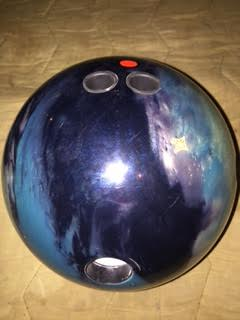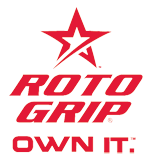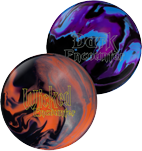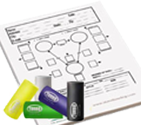I’ve always been a fan of
smallish, round symmetrical cores.
They’ve always seemed to roll best for
me.
So when I saw the new MadcapTM core
for the DARE DEVIL, I was intrigued.
Roto Grip says it’s the lowest RG
symmetrical core ever to have been featured in
the HP-3 line.
The cover is called Amped
Pearl Reactive, a new coverstock which is “built
for insane down lane action…that tees off of
friction for incredible response and entry
angle.”
Prerelease forecasts about the
DARE DEVIL told me to expect ball motion in between
what we experienced from the much loved MARVEL PEARL
and the popular !Q TOUR PEARL.
The tech specs bear that out.
The RG at 15 lbs. is within one one-hundredth
for all three.
The variance is in the differential: 0.041 on
the DARE DEVIL compared to 0.050 (more flare
potential) on the MARVEL PEARL and the uniquely low
0.029 (less flare potential) on the GOLD BALL.
Due to schedule
restraints this fall I am only bowling league these
days and that means typical STL wet/dry house shots.
Unfortunately, some weeks it also means less
than optimal mechanics from this old guy’s body.
Nonetheless, given the DARE DEVIL’s target
performance setting of medium volume conditions, I
anticipated good things.
Before I had a chance to send mine down the
lane, I saw great motion from the DARE DEVIL in the
hands of local fellow STL Roto Grip staffer and
higher rev player, Shea Bittenbender.
Overall, I think the DARE DEVIL is going to
prove a more versatile piece for bowlers with more
hand.
What I have seen
for myself has also been really good ball motion
when I get it
rolling off my hand well.
This
makes sense given the moderate flare potential, or
as national tour Roto Grip Staffer, John
Szczerbinski put it “medium friction and
medium/quick response time.”
Medium response time means that the ball
needs to see dry in order to perform optimally, but
when it does see dry it doesn’t jerk left quickly
off the spot.
Instead the motion off the spot is more
medium-range in volatility.
To my eye, oftentimes that means more of what
I would call forward motion off the spot rather than
sideways.
The way this has played out for me has been
pretty consistently the same in league outings.
Typically targeting from about 5 or 6 boards
inside the oil line at the laydown point, across it
the oil line past the arrows, and out to the dry
down lane I’ve had solidly good games in the 240 to
250 range the first game each week.
When I’ve had to start migrating left the
second game, the result has also been the same each
week – a clean game with four to six ringing ten
pins for 200 to 220.
And I’ve had to put the DARE DEVIL away the
third game in favor of something more angular down
lane as I get deeper into the heavier, longer part
of STL house patterns.
I anticipate the
DARE DEVIL being really useful for me on flatter,
medium volume and medium length patterns once they
start to transition.
As mentioned, I think bowlers with more hand
will be able to stay with the DARE DEVIL longer as
lanes transition because they’ll be able to get it
to corner harder than I can.
Similarly, bowlers with less hand or more
ball speed will probably find the DARE DEVIL a great
go-to ball that will let them stay direct up the
lane through a pattern when what they’ve started
with starts to check up too soon.
Mine will probably spend more time in my
tournament bag than my league bag.







